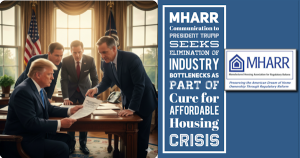MHARR AGGRESSIVELY RESISTS HUD PLAN TO FEDERALIZE INSTALLATION
MHARR has received numerous inquiries from industry members and other HUD program stakeholders regarding a rapidly-widening power grab by program administrator to effectively federalize installation regulation in all 50 states, forcing changes to or, in some cases, totally displacing (or seeking to displace) state law installation standards and programs that were previously approved by HUD. This effort began with HUD’s attempt to force unilateral changes to state standards for so-called “frost-free” foundations – which MHARR objected-to immediately — via an alleged “interpretation” (actually a substantive modification) of the federal standard for such foundations, which the program administrator ultimately stated would be binding in all 50 states. Meanwhile, against the backdrop of this “Trojan Horse” effort, the HUD program, on a parallel and concurrent track, through its installation contractor, has intensified already-aggressive demands on state-based programs to tow the HUD line on all aspects of standards and enforcement, leading a number of states to consider leaving the program (with the status of the Michigan program unclear at the writing of this article), or under threat from HUD.
HUD – and some uninformed elements within the industry – excuse this gross over-reach as a consequence of the structure and language of the Manufactured Housing Improvement Act of 2000, which reserves to the states the right to regulate installation through state-law programs which provide “protection” to home occupants that meet or exceed the baseline of protection established by the Part 3285 federal installation standards. But, as MHARR – a full participant in the development of the 2000 reform law — has maintained consistently over the nearly two decades that have since elapsed, this subjective baseline does not give HUD the right to either supplant state-law programs that have already been approved by the Department, or demand the modification of state law installation regulations based upon “interpretations” of the HUD standards or unilateral HUD modifications of those standards – by any means.
In other words, once a complying state adopts a compliant state program, any change to that program thereafter, over and above the federal standards, is up to that state, not HUD. What HUD is seeking through its new policy is effectively a “mulligan” – a “do-over” on installation that is not to be found in the 2000 reform law.
As MHARR has previously explained (see, e.g., the March 2016 edition of the “MHARR Viewpoint” published in the Journal of Manufactured Housing):
“Recognizing … that proper installation is crucial: (1) to the proper performance of a manufactured home; (2) to the value of that home to its owner and consumer finance providers; and (3) to public and government acceptance of manufactured homes as legitimate “housing,” rather than “trailers,” the industry and consumers went back to work for nearly 12 years, together with other stakeholders, to develop the installation provisions that were ultimately included in the 2000 reform law.
The result was a statutory structure, based on the 1994 recommendations of the National Commission on Manufactured Housing, which authorized any state that wished to do so (i.e., a “complying” state), to establish (or continue) a state-law installation program and state-law installation standards, so long as those requirements provided protection that met or exceeded baseline federal standards to be developed by the Manufactured Housing Consensus Committee (MHCC) and adopted by HUD. HUD, by contrast, was authorized to regulate installation in non-complying (i.e., “default”) states that failed to adopt a state-law installation program within five years of enactment of the 2000 law.
This structure – which had been aggressively advanced by MHARR — was consistent with the nearly-universal view of program stakeholders that varying soils and other installation-related conditions in different geographical areas made states the best and most appropriate party to regulate the siting of manufactured homes. The 2000 reform law, consequently, allows states to take the lead role in the regulation of installation, with HUD assuming that duty only in default states that fail to adopt and implement a conforming state-law program.
What the 2000 reform law specifically does not do, however — again recognizing, as it does, the unique competence and ability of the states and state authorities to determine proper installation systems and techniques within their own borders – is authorize or direct HUD to substitute its judgment for that of state authorities regarding the specific details and elements of any given state installation standard. Put differently, the 2000 law allows HUD to determine whether a state-law installation program and state-law installation standards as an integrated “whole” provide consumers with a level of protection equal-to-or-greater-than the HUD standards, but does not provide back-door authority for HUD to micro-manage state-law programs and/or standards or over-ride state judgments regarding the need for — or content of — any specific installation requirement.”
(Emphasis added).
Let there be no mistake. What the HUD program, under its current administrator, is engaged in now, is a de facto coup against the states to displace their rightful regulatory authority over installation as provided and guaranteed by the 2000 reform law, and is seeking to replace that authority with federal mandates. These changes not only undermine the federal-state partnership that lies at the heart of the HUD program, but for every state that is pressured or displaced, the power and authority of federal regulators and contractors expands far beyond what was ever intended by Congress and the law, with those states effectively becoming part of HUD’s domain. Worse yet, this power grab by HUD and its contractors is effectively facilitated by a segment of the industry, which has failed to join MHARR in seeking fundamental changes to the program and its leadership in accordance with the regulatory policies of the Trump Administration.
MHARR, for its part, has – and will continue — to aggressively oppose HUD efforts to displace state installation authority, while seeking the leadership changes that a rapidly-deteriorating HUD program desperately needs.
(Photo Image Credits: US Capitol Building -Buck.House.gov)













